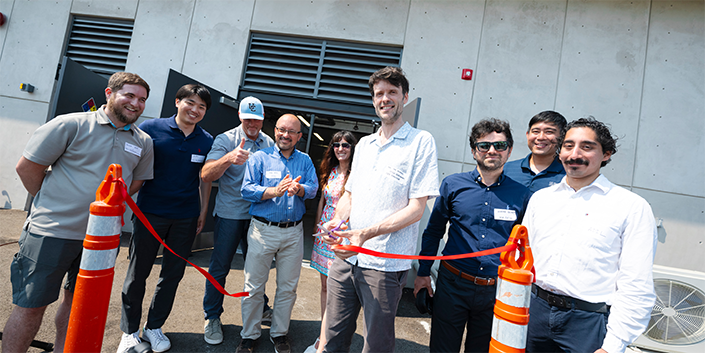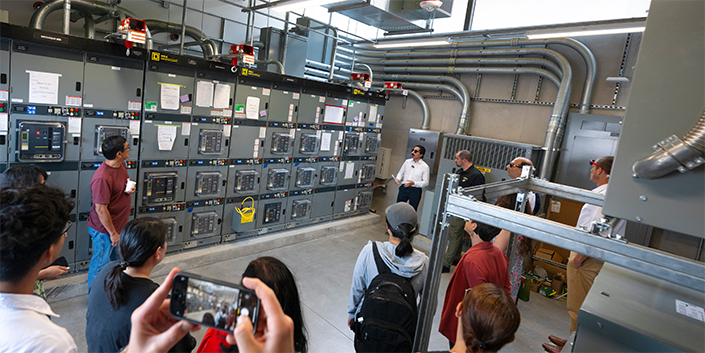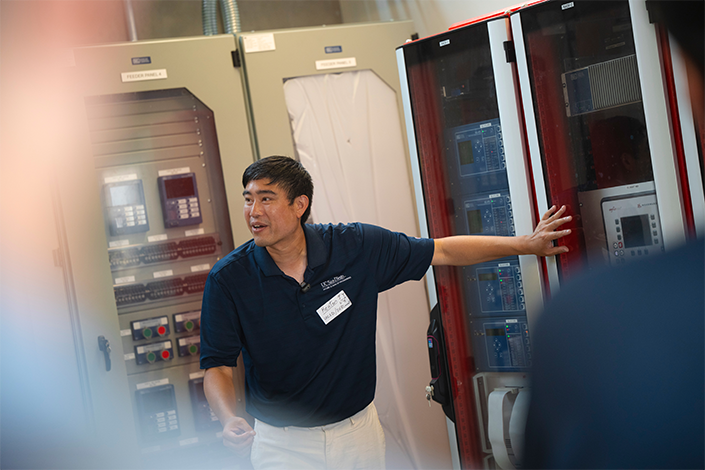New $42M Grid-Tech Sandbox Will Help Get More Renewables on Electric Grids
Story by:
Published Date
Article Content
A dozen buildings on the University of California San Diego campus. All of the campus’ solar panels. All the chargers for electric vehicles. More than 2,400 light fixtures. More than 800 smart plugs.
These are some of the assets that DERConnect, a National Science Foundation-funded testbed for the powergrid, will be able to control on the UC San Diego campus. The team held a ribbon cutting ceremony at its brand new headquarters on the UC San Diego campus on July 11, 2024.
DERConnect’s goal–supported by a $42 million grant from the NSF–is to help industry and academic researchers better understand how to integrate ever more distributed energy sources such as solar panels, wind turbines, smart buildings and electric vehicle batteries into the power grid.
“We are replicating the entire California power grid in one campus,” said Jan Kleissl, a professor in the Department of Mechanical and Aerospace Engineering at the UC San Diego Jacobs School of Engineering and the project’s principal investigator.
The DERConnect headquarters include batteries that can store power produced by solar panels to be used later on the grid–enough to power several campus buildings. One room is dedicated to servers and computers capable of simulating power grids for entire cities and entire states. One room is dedicated to small Raspberry Pi computers that control individual devices on the UC San Diego campus’ microgrid, such as electric vehicle charging stations, printers, TVs, smart plugs and more. Another room houses devices that act like giant breaker boxes to turn all these assets on and off.
The glue that connects these facilities together is the DERConnect team, which is hard at work finalizing this hardware and software electric-grid-tech sandbox, which will be available for use by both on-site and remote researchers.
In fact, engineers from both industry and academia will be able to use DERConnect to ask a wide range of important questions that must be explored in real-world environments in order to create resilient, decarbonized grids of the future.
Questions like: During a heat wave when the grid is stressed, what kind of algorithms are best to balance the variable energy input from solar panels and the energy output requests from people charging electric cars?
Or: When energy demand spikes and yet the wind stops blowing unexpectedly, what kind of autonomous control systems can be deployed to keep the grid stable while also meeting all the needs of people served by the grid?
A preliminary study that used DERConnect’s ability to control on-campus devices showed that turning off devices that control air flow for rooms in a building outside of business hours could cut energy costs in half. Researchers estimate that the same savings can be achieved by turning off printers and TVs when not in use.
The creation of the DERConnect testbed addresses an outstanding national need for large-scale testing capabilities across universities, national labs, industry, utility companies, and Independent System Operators to validate future technologies for autonomous energy grids in real-word scenarios. In fact, a major obstacle to the adoption of many advanced technologies in the operations of real-world energy systems is the development of realistic test cases at relevant scales.

“The U.S. power grid is one of the biggest man-made machines in the world,” said Keaton Chia, the lead research engineer on DERConnect. “That is the scale we are operating on.”
Most utilities struggle with the fact that renewable and distributed energy sources are not as stable as traditional sources, such as natural-gas power plants. Solar panel output depends on the weather, as do wind turbines. At the other end of the grid, electric vehicles need charging for only a certain amount of time every day, and when not in use could be used as temporary batteries to store energy from renewables.
As a result, while the number and diversity of distributed energy resources on the power grid is rapidly expanding, the adoption of these resources for power-grid balancing is hindered by concerns about safety, reliability and cost.
“The reality is that no-one knows exactly what the grids of the future will look like. The energy sector is changing fast – and at the same time, energy demand is rising and the grid-control tools at our disposal, including tools incorporating artificial intelligence, are moving fast and could potentially change the grid landscape. We designed DERConnect as a flexible research platform to allow researchers to dig into some of the hardest hardware, software and controls questions related to distributed grids of the future,” said Kleissl. “I am excited to see the many different ways our platform will be used in efforts to create the decarbonized energy future that we need.”

Offering utilities, researchers from industry and academia, and other entities a testbed with real-world communications and control challenges is essential to solve these problems and develop new distributed control theories, algorithms, and applications.
In addition to principal investigator Kleissl, the research team includes co-PIs professors Sonia Martinez, serving as deputy director, Jorge Cortes and Raymond de Callafon, in the Department of Mechanical and Aerospace Engineering at UC San Diego; Professor Rajesh Gupta, director of the Halicioglu Data Science Institute at UC San Diego; and the DER Connect staff team at UC San Diego including Kohei Murakami, Sayed Sadat, Jesse Wolf, Shivangi Shakya, and Anthony Cho.
Additional senior personnel include UC San Diego Professors David Victor and Joshua Zivin from the School of Global Policy and Strategy; Mike Ferry from the UC San Diego Center for Energy Research; Ilkay Altintas, chief data science officer for the San Diego Supercomputing Center at UC San Diego; and DERConnect project scientist Adil Khurram.
Industry partners include Johnson Controls and Minsait ACS.
Learn more about research and education at UC San Diego in: Climate Change

Share This:
You May Also Like
Stay in the Know
Keep up with all the latest from UC San Diego. Subscribe to the newsletter today.




